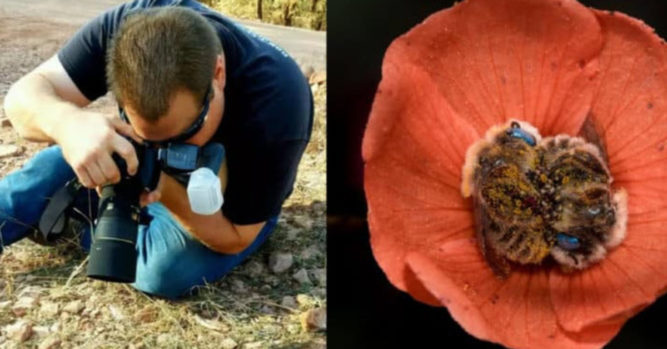
What is your reaction when you see a honeybee? If you are like most people, the first thing you want to do is to get away from the area. You may even find that you are flailing your arms wildly in an attempt to keep them from stinging you. Of course, nobody wants to get stung by bees and if you are allergic, it could even be a matter of life and death. That doesn’t stop the fact that they are still an important part of our day-to-day lives.
The world has become more and more aware of the fact that we need bees in order to survive. They pollinate the food crops that we eat so without them, we would have a lot less food on the table. Seeing them buzzing around is actually a sign that all may just be right with the world. What you may not think about when it comes to bees is the fact that they need sleep. Just like every other creature on the face of the earth, without shuteye, they will soon shut down. That is where Joe Neely comes in. He is a wildlife photographer and recently captured a picture that has captivated the world.

“The story behind this photos [begins when] me and my fiancé Niccole went out to find poppy flowers,” Neely said. “On the way back we saw this patch of pink flowers just off the highway so we stopped to take some photos.”

“Niccole was shooting over this since orange Globe Mallow plant that was hidden inside all of these pink flowers and she heard the bees buzzing about,” the 38-year-old from Phoenix, Arizona, said. “Then she notices that some of the flowers had bees in them but they were not moving.”

“I came over and study it for a while and more bees showed up. Soon, all the vacant flowers were occupied and this one bee was left out. She crawled over to this open flower and got inside with the other one. I was watching as he stumbled around almost drunk-like and then got settled in.”

“Well, I never knew that bees slept in flowers but as it turns out these bees (Diadasia diminuta) sleep in the orange flowers called Globe Mallows.”
The Forest Service at the United States Department Of Agriculture said that you will usually find nests of these bees along dirt roads in the partially compacted soil. They are also very important for the reproduction of flowers.
“The bees become covered with pollen visiting the flowers [and] most of this pollen is groomed into the pollen basket on the hind legs and taken back to the nest,” the organization writes on its website. “However, some remains on the body and is deposited on the stigma of each of the next few globe mallow flowers visited. Thus, Diadasia contributes to globe mallow reproduction.
“They don’t have eyelids, so you can’t just look for bees with their eyes closed,” Brandon Hopkins, a bee researcher at Washington State University, said. “By carefully watching bees, scientists have found that honey bees stop moving their antenna and in some cases fall over sideways.”
The planet Earth is home to more than 20,000 known species of bees. Some of them work day and night, such as honeybees but they take shifts so that they can get their shut-eye. Younger bees don’t need as much sleep as older bees but sometimes, they may take naps in shifts of around 30 seconds.

Joe had a winning shot with these two globe mallow bees cuddled up in the flower. “I used a Nikon d750 and a 150mm macro lens along with an R1C1 Nikon macro flash,” he revealed. He considers this to be the same as any other type of wildlife photography.

“I keep a respectable distance and don’t do anything that would change the subject’s behavior. How macro photography is different is that your depth of field is very small or shallow because you are very close to something so tiny. So because of this, I like to shoot with an aperture around f16 to f20, in order to get as much in focus as possible. This usually means there will be a need to introduce artificial lighting, like a flash. Now that may sound annoying but the best part about using a flash is that you don’t have to depend on a fast shutter speed for sharp images. Instead, you are freezing all movement(yours and the subjects) with the speed of light.”

People loved what they were seeing in this picture:









